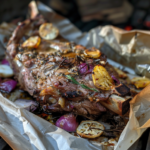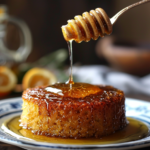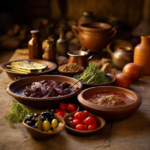Greek Orthodox Easter, known as Pascha, is rich in cultural and religious significance, and this extends deeply into the culinary traditions associated with the holiday. The foods prepared and consumed during this time are not only delicious but also carry symbolic meanings that reflect the spirit of the season. This post explores some traditional Greek Easter recipes, their cultural significance, and how they contribute to the celebration of this major religious holiday.

Greek Easter Recipes; Tsoureki (Greek Easter Bread)
Tsoureki is a sweet, brioche-like bread that is a staple during Greek Orthodox Easter. It’s characterized by its soft, fluffy texture and aromatic flavor, infused with essences of orange zest, mahlab (an aromatic spice derived from cherry seeds), and mastic (a resin gathered from the mastic tree on the Greek island of Chios). The bread is traditionally braided, often with a red-dyed hard-boiled egg nestled within its strands. The red egg symbolizes the blood of Christ and the resurrection, while the braid represents the Holy Trinity.
Greek Easter Recipe Insight: Making Tsoureki is a loving process that involves patience as the dough must be allowed to rise multiple times to achieve its characteristic texture. The bread is perfect for breakfast or as a snack, paired with coffee or tea.
Magiritsa (Easter Soup)
After the midnight service on Holy Saturday, the fast that lasts throughout Lent is traditionally broken with Magiritsa. This soup is made from lamb offal, symbolizing the Lamb of God and reflecting the pastoral traditions of Greece. It’s seasoned with spring onions, dill, and sometimes rice or lettuce, then thickened with an avgolemono (egg-lemon) sauce. This dish prepares the stomach for the richer foods that will be consumed on Easter Sunday.
Greek Easter Recipe Insight: Magiritsa can be challenging for those not used to eating offal, but it’s a deeply traditional dish meant to ease the body back into eating meat after the long fast of Lent.
Greek Easter Recipes; Lamb on the Spit

Easter Sunday in Greece is unthinkable without a whole lamb roasted on a spit. The lamb is an important symbol of Christ as the sacrificial Lamb of God. Families gather outdoors, taking turns at the spit, which cooks the lamb slowly over several hours. The lamb is typically seasoned with generous amounts of lemon, garlic, and herbs, such as oregano and rosemary, which permeate the meat with robust flavors.
Recipe Insight: Roasting a whole lamb requires equipment and space, but the communal activity is a central part of the celebration, signifying unity and joy.
Greek Easter Recipes; Koulourakia (Easter Cookies)
These butter-based cookies are a delightful treat during Greek Easter Recipes. Koulourakia are hand-shaped into twisted or braided designs and have a sweet, subtly citrus flavor. They are typically enjoyed after the Holy Saturday Resurrection service and throughout the following week.
Recipe Insight: Koulourakia are fun to make with family, especially involving children in shaping the dough. They are perfect for dipping in coffee or milk.

Greek Easter Recipes Red Dyed Eggs
Red eggs are perhaps the most symbolic food of Greek Easter. The eggs are dyed on Holy Thursday and represent the blood of Christ, with the hard shell symbolizing the sealed Tomb of Christ. The cracking of these eggs is a traditional game played at the Easter table called “tsougrisma,” symbolizing the breaking open of the tomb and Christ’s resurrection from the dead.
Recipe Insight: The key to perfect red eggs is using good quality dye and adding a tablespoon of vinegar to the dye bath to set the color. Once dyed, the eggs are polished with a bit of olive oil to give them a glossy sheen.
Conclusion
These Greek Easter recipes offer a taste of Greek Orthodox Easter, blending rich flavors with deep religious symbolism. Each dish plays a role in the narrative of Pascha, making the holiday not only a feast for the palate but also a profound cultural and spiritual reflection. Whether you are of Greek heritage or simply interested in experiencing how another culture celebrates this significant time, trying your hand at these recipes can provide a delicious insight into Greek Orthodox traditions.
Frequently Asked Questions About Greek Easter Recipes
What is Tsoureki? Tsoureki is a traditional Greek Easter bread that’s sweet, fluffy, and aromatic. It’s similar to a brioche and is often flavored with orange zest, mahlab, and mastic. Tsoureki is typically braided and decorated with red-dyed eggs, which symbolize the blood and resurrection of Christ.
How is Magiritsa typically served? Magiritsa is served to break the fast of Lent after the midnight Resurrection service on Holy Saturday. It’s a rich soup made from lamb offal and seasoned with spring onions, dill, and lemon, thickened with an avgolemono sauce. This dish is intended to gently reintroduce meat into the diet after the Lenten fast.
Why is lamb traditionally served on Easter Sunday in Greece? Lamb is served on Easter Sunday as it symbolizes Jesus Christ as the Lamb of God. Roasting a whole lamb is also a festive way to mark the end of Lent, and it’s a dish that encourages communal participation and celebration.
What are Koulourakia? Koulourakia are traditional Greek Easter Recipes – cookies. They are sweet, buttery, and often contain a hint of citrus flavor. These cookies are usually twisted or braided into various shapes and have a delightfully crisp texture. They are commonly served with coffee or milk and are a favorite among children.
How do you properly dye Easter eggs red? To dye Easter eggs red, you will need red egg dye and vinegar. Boil the eggs with a tablespoon of vinegar, which helps set the dye. Once boiled, place the eggs in a dye bath following the dye package’s instructions. For a glossy finish, polish the dyed eggs with a little olive oil.
What is the significance of red-dyed eggs in Greek Orthodox Easter? Red-dyed eggs symbolize the blood of Christ and his resurrection. The shell represents the sealed tomb of Christ, and cracking these eggs during Easter celebrations symbolizes Christ breaking free from the tomb. This tradition is a joyful part of the Easter meal and involves a game where family members tap their eggs against each other’s to see whose egg will remain uncracked the longest.
Can non-Greeks enjoy Greek Easter recipes? Absolutely! Greek Orthodox Easter recipes are rich in flavor and steeped in cultural significance, making them enjoyable for anyone interested in culinary exploration. These dishes offer a wonderful insight into Greek culture and traditions, regardless of one’s background.
Are there vegetarian options for Greek Orthodox Easter? Yes, many traditional foods served during Greek Orthodox Easter can be adapted for vegetarians. While dishes like Magiritsa and lamb are inherently meat-based, others like Tsoureki and Koulourakia are naturally vegetarian. Additionally, many Greek dishes made with vegetables, legumes, and grains can be incorporated into the Easter meal.
These FAQs aim to enrich your understanding of Greek Orthodox Easter culinary traditions, helping you appreciate the deeper meanings behind the dishes and perhaps inspire you to include some of these recipes in your own Easter celebrations.
This journey into the heart of Greek Koulouri Thessalonikis is brought to you by Digital Marketing Company Digital Heroes Caffe and Financial Navigator 360, connecting you to the roots of Greek culinary heritage, one recipe at a time.
Additional Resources:
Embark on a culinary journey with Greek Koulouri Thessalonikis, and let the flavors tell you stories of Greek mornings filled with love, tradition, and a touch of crispness.
Explore the variety of Traditional Greek Breads that share the rich culinary heritage with Greek Koulouri Sesame Bread Rings.
Kickstart your morning with Greek Breakfast and Brunch items, featuring the delightful Greek Koulouri Sesame Bread Rings
Master the Greek Baking Techniques that are quintessential in crafting the perfect Greek Koulouri Sesame Bread Rings
Discover Athens’ Best Bakeries where Greek Koulouri Sesame Bread Rings are a beloved staple


















